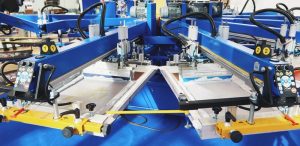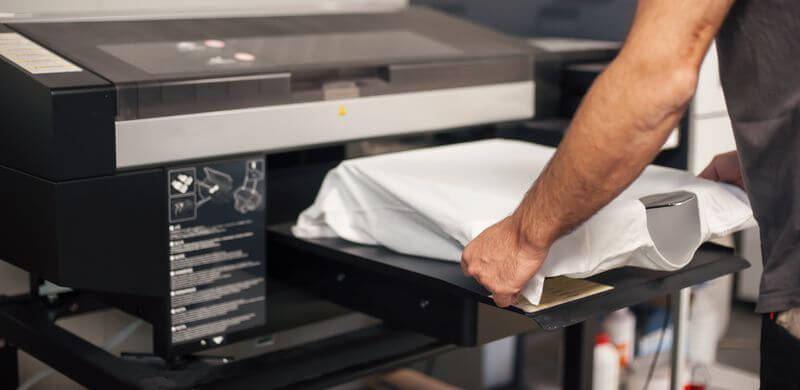DTG vs. screen printing, the battle between these two printing methods has been raging for some time now. It is long overdue to bury the hatchet by weighing their pros, cons, and finally give a verdict on which works best for dropshipping and print on demand.
Whether you’re a tireless entrepreneur driven by success, an artist longing to showcase your creative flair to the world, or simply someone who’s finally ready to dip their toes into a more adventurous fare than a 9-to-5 job, choosing the right printing method can make or break your apparel business.
In this article, we’ll help you to fine-tune your knowledge of both direct-to-garment (also known as DTG) and screen printing. We’ll answer all of your questions about their differences – quality, cost, durability, and other features – so you can choose what suits your business the best.
Let’s get started.
What Is Screen Printing?

Screen printing is a tried-and-true printing technique where a mesh stencil is used to transfer ink onto fabric. It is one of the oldest printing methods that dates back thousands of years. However, it only exploded into modern culture during the 1960s with the popularity of Andy Warhol, the printed t-shirt trend, and the invention of multicolor screen-printing machines.
This ancient art technique is also known as silk screening, because it was first intended to stencil silk. The printer creates a stencil on a fine mesh screen, then pushes the ink through it to achieve the desired outcome – imprinting the design on a chosen garment.
This method requires the use of thick inks, causing them to lay on top of the material rather than soaking into the fabric. If you want to create multicolored designs, the ink has to go on in several layers, with a different stencil for each ink. Unfortunately, here lies the problem – the more layers your design has, the longer it will take to print it.
What Is DTG Printing?


Direct-to-garment printing, or DTG, is a printing process that involves spraying ink onto a garment using specialized or modified inkjet technology, then waiting for it to soak into the fabric. Although it’s only been around for about 20 years, it has revolutionized the fashion industry in ways that nobody expected. Currently, DTG printing is in a rapid growth phase and has proved to be one of the print industry’s most resilient sectors during the Covid pandemic.
With direct-to-garment printing, very little setup time is required. This means that it’s easy to print one-off items. If you have an online store connected to a print provider that offers DTG printing, the process is smooth and simple. How exactly does DTG printing work? As soon as your customer buys from your digital store, which is integrated with a print-on-demand platform like Printify, the manufacturer is instantly notified and begins the printing process. After, the order will be packed and shipped directly to your customer.
With Printify’s print-on-demand services and global DTG print provider network, it’s really simple to get started. There’s no minimum order quantity and no up-front investment is required. Basically, you can start printing and selling your own one-of-a-kind items in no time at all.
DTG vs. Screen Printing: Which Is Better?
DTG and screen printing are two of the most common and popular methods for custom apparel printing. DTG uses a specialized fabric printer – a bit like computer inkjet printing – to spray the ink into a garment, while screen printing layers the ink on the surface of the fabric.
Both of these printing methods produce high-quality prints, however, each of these has its pros and cons. Their capabilities differ, and it’s up to you to choose the one that works best for your apparel business. Let’s take a look at each of these methods in depth and see what they’re all about.
Quality
Whether you intend to print on custom t-shirts, hoodies, sweatshirts, or any other type of apparel, the quality of the print is of paramount importance to satisfy your customer’s expectations.
The hallmark of screen printing technology is its vibrant, saturated, high-quality prints. There’s no doubt about it, but unfortunately it’s limited to specific colors, requires a lot of time, and is wickedly labor-intensive.
With DTG printing, however, you can enjoy the same high-quality prints with less cost. This method allows you to print highly detailed designs and photorealistic images which look as good or even better than when other printing processes – such as screen printing – are used.
Bella Canvas
When it comes to printing for profit, DTG print offers several advantages and is the go-to printing technique for designers, creatives, and other print-on-demand entrepreneurs.
Durability
In our modern throw-away society, people find durable goods refreshing. Well-made products that are built to last and can stand the test of time are becoming increasingly valuable and, sad to say, rare.
If care instructions are followed correctly, DTG prints can withstand over 50 washes and still remain acceptable to your customers. Screen printing lasts anywhere from 25 to 50% longer and is ideal for something like sports or business uniforms, but if you’re looking to sell custom t-shirts or other custom apparel – DTG prints are the way to go.
Design Complexity


In the printing industry, details are the smallest parts of the design, such as textures, fine lines, or tiny elements. When it comes to details, DTG printing is an undisputed champion. It is usually recommended for full-color designs with lots of details like illustrations, photographs, gradients, etc. Screen-printed garments, however, have dots that are visible to the naked eye, whereas with DTG printing, the resolution is phenomenal – you can’t see them at all.
By using direct-to-garment printing you can remain confident that your extremely detailed and intricate designs will come out of the printer just as you intended. You can pick any product from our catalog and see how it will look. follow recommendations on file size, colors, and a few other things explained in our Design Guide.
Make It Happen Today!
Sustainability
With green living on the rise, the sustainability of the products we use becomes more important. You’ll be pleasantly surprised to know that print on demand is one of the most sustainable business models out there. A bit of a game-changer, this one. Did you know that 92 million tons of textile go to waste every year? Printing a one-off product saves money, avoids overproduction and waste, and helps the environment.
When compared to its counterpart, DTG printing is a more sustainable option. Why? Because using DTG printing, the product is made only after it has been bought. It happens automatically, too. DTG printing machines typically use environmentally-friendly, water-based inks, and the process itself is highly energy-efficient.
With screen printing, however, overproduction is common. It generally works well with printing items in bulk quantities, which, unless sold, may end up in landfills or be burned.
A lot of DTG printing machine manufacturers have sustainability in mind. They develop digital printing solutions that are more environmentally friendly than both traditional and other digital printing methods in the industry.
Minimum Order Quantity


One of the main reasons people choose DTG as their favorite on-demand printing method is that there’s no minimum order quantity. You can order as few or as many items as you like. DTG printing is perfect for small orders. It is a great t-shirt printing method, too. Additionally, the prices are always reasonable, and the process is hassle-free.
Things are a little bit more difficult with screen printing. A lot of third-party print services have minimum order requirements that can be from 5 to 100 items. If you’re just starting out or simply want to experiment with new designs, screen printing makes the whole process rather time consuming and difficult. You just might find yourself overwhelmed by the cost and suffocating under piles of clothing.
Production Time
When it comes to the speed of production, DTG printing can’t keep pace with screen printing. However, screen printing requires a setup time that offsets its speed. That’s why screen printing works best for bulk orders – once the stencils are created, the production moves ahead quickly. Some screen printing presses can print up to 1,080 pieces an hour.
Even though DTG printing is slower than other printing methods, it’s perfect for print on demand. You can print just one, and if the product does not sell, you can replace it or discontinue without worrying about inventory. This method is great for those who want to enter a new market with a low budget.
Average Cost
Whether you’re just playing with the idea of starting a clothing line or thinking about scaling your existing business, you need to choose a printing method that will meet your business goals in the most cost-effective way.
There are a few things you need to remember. If you want your products to be screen printed, be ready to order in bulk. The setup makes screen printing too expensive – and inefficient – for low-quantity orders with lots of colors. The final price of your order is also influenced by the number of colors and screens that are needed to print it. Unfortunately, this is how screen printing works – it can be financially challenging. As always, all of these details should be discussed with your print provider.
DTG printing reduces the setup costs for a single piece of garment and allows for an easy and affordable production process. But not for the manufacturer, mind you. Their costs are astronomical. It’s not a concern for a regular print-on-demand user. With this method, you can print a single product and still make a profit.
DTG vs. Screen printing: Conclusion
As with every new technology, there are a lot of unknowns, but we hope that this overview gives insight into the modern DTG printing method. By comparing it to its older counterpart, screen printing, you can pick the one that suits your business best. Before making the final decision, be sure to think about your needs. They include, but are not limited to:
- Your capacity for up-front investment
- The complexity of your designs
- Product quantity
- Your brand image
In one word? Choose your printing method wisely. It is not an easy task, but to make it easier we’ve prepared a brief summary of the advantages and disadvantages of these printing methods.
| Direct-to-garment printing | Screen printing | |
|---|---|---|
| Quality | Unrivaled, photorealistic high-quality prints | Vibrant high-quality prints |
| Durability | Able to withstand over 50 washes | The best choice for garment longevity |
| Design complexity | Excellent for extremely detailed and intricate designs | Difficult to print finer details; perfect for less detailed designs |
| Sustainability | Typically uses environmentally-friendly, water-based inks The process is highly energy-efficient |
Screen printing can be dirty and messy, requires a lot of water Overproduction is a common occurrence |
| Minimum order | You can order as few or as many as you like | Has minimum order requirements, usually from 5 to 100 |
| Production time | Slow, but cost-effective and profitable for small orders | Perfect for bulk orders. The production moves much faster than its counterpart, once setup is done |
| Average cost | An affordable and efficient way to print small orders Not cost-effective for bulk orders |
Costly for small on-demand orders, great for printing in bulk More colors equal more cost |
| Quality | |
|---|---|
| Direct-to-garment printing | Unrivaled, photorealistic high-quality prints |
| Screen printing | Vibrant high-quality prints |
| Durability | |
| Direct-to-garment printing | Able to withstand over 50 washes |
| Screen printing | The best choice for garment longevity |
| Design complexity | |
| Direct-to-garment printing | Excellent for extremely detailed and intricate designs |
| Screen printing | Difficult to print finer details; perfect for less detailed designs |
| Sustainability | |
| Direct-to-garment printing | Typically uses environmentally-friendly, water-based inks The process is highly energy-efficient |
| Screen printing | Screen printing can be dirty and messy, requires a lot of water Overproduction is a common occurrence |
| Minimum order | |
| Direct-to-garment printing | You can order as few or as many as you like |
| Screen printing | Has minimum order requirements, usually from 5 to 100 |
| Production time | |
| Direct-to-garment printing | Slow, but cost-effective and profitable for small orders |
| Screen printing | Perfect for bulk orders. The production moves much faster than its counterpart, once setup is done |
| Average cost | |
| Direct-to-garment printing | An affordable and efficient way to print small orders Not cost-effective for bulk orders |
| Screen printing | Costly for small on-demand orders, great for printing in bulk More colors equal more cost |
In Summary
As eCommerce continues to surge and print on demand becomes increasingly profitable, it’s a worthwhile endeavor to find a printing method that’s right for you.
If you’re just starting out, DTG printing is your best bet. It’s perfect for introducing new designs to the market with little cost. Here’s why:
- Photorealistic image quality. When it comes to details, DTG is king.
- Cost-effective. With print on demand, no investment is required.
- No minimum order quantity. You can order as few or as many as you like.
- Environmentally friendly. Today’s technology allows for the use of eco-friendly inks.
Screen printing, on the other hand, is perfect for those who are ready to order in bulk, have a bit of capital, and storage space. Here are its main advantages:
- Cost-effective when ordered in bulk. For large orders, screen printing typically costs less.
- Lasts longer. The best choice for longevity of the garment.
- Extremely vivid colors. Vibrant, saturated, high-quality prints.
- High production speed. Once setup is done, production moves quickly.
If you’re interested in opening your own print-on-demand eCommerce store, entering a new market, or scaling your existing business, DTG printing is the way to go.
Make It Happen Today!
The post DTG vs. Screen Printing: What Everyone Needs to Know appeared first on Printify.







